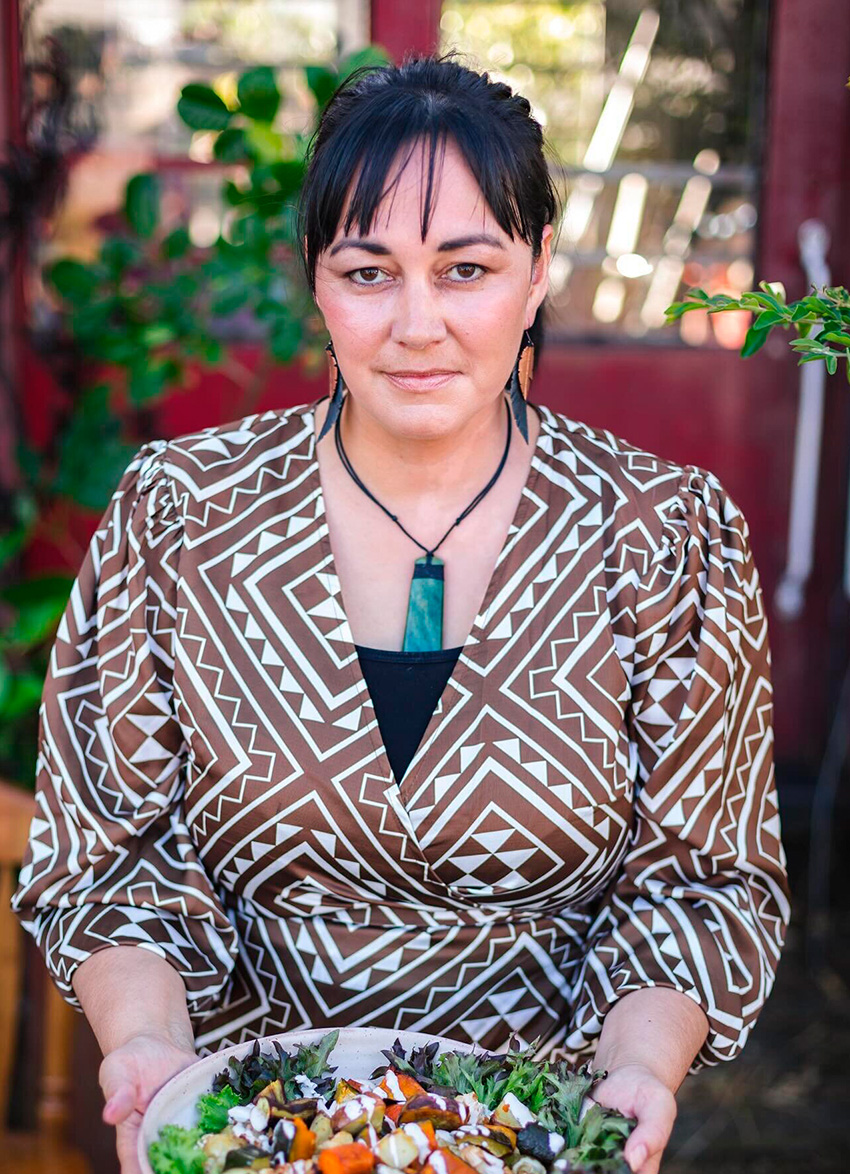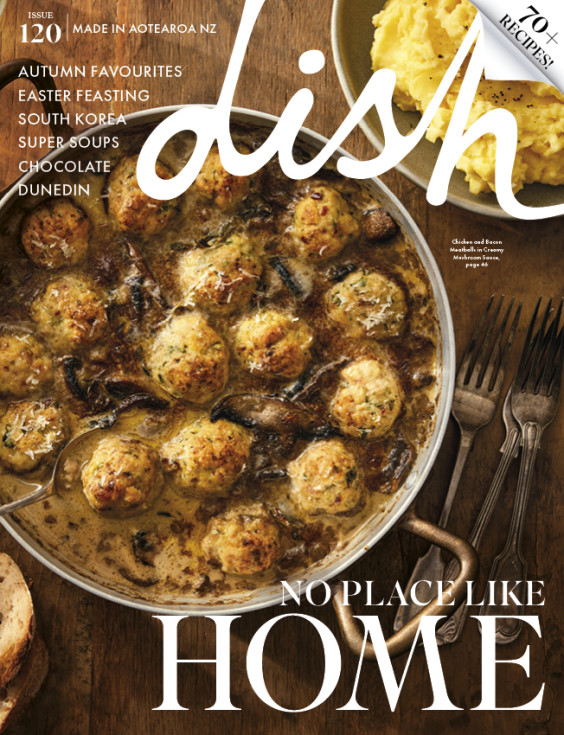A Foodie Chat with Kai Feast Author, Christall Lowe

Kai Feast, food writer, stylist and photographer Christall Lowe's second cookbook, focuses on manaakitanga – hospitality and generosity – and whanaungatanga – the importance of gathering and sharing kai with loved ones. To find out a bit more about Christal and her connection with food, dish Editor, Sarah Tuck met for an interview with her.
Following on from the success of your first book Kai, what is it that you wanted to share with Kai Feast – what makes it special for you?
My first book Kai is a collection of stories and recipes inspired by my family’s “life of kai”, interwoven with cherished food memories, mauri (life essence) and delicious photography. Kai Feast is a continuation of this food story, but with a focus on manaakitanga – hospitality and generosity, and whanaungatanga – the importance of gathering and sharing kai with loved ones.
It’s a story of feasting which flows from the mountains to the sea, a bountiful basket of kai and kōrero infused with the flavours of Aotearoa, and it’s lip smackingly good kai too. I delve deep into the heart of my family pātaka (storehouse), digging out treasured family recipes and notes, creating dishes inspired by flavour memories, and not just dishing up the best of the best for festive occasions but also serving it with tales of nostalgia and stories of traditional feasting. There’s a lot of precious photos throughout too, of our feasts over the years, which sets the scene for the ultimate feast.
Can you tell us about Christmases growing up – how did food play a part in your time with whānau, and what were your favourite dishes?
Our Christmases growing up were epic, to say the least. We would always have two occasions in one day – one with Mum’s side of the family, and one with Dad’s, always at our Grandparents’ houses. The house would be jam-packed with cousins, all eager to rip into the presents and eat the lollies from off the decorated tables – and aunties who would be guarding the presents and shooing us outside until it was time for the “grand opening”.
The kai was always the feast of all feasts. More often than not we would have hāngī that had been put down in the backyard (yes, that meant sometimes two hāngī in one day!), as much kaimoana (seafood) as anyone could bring, and a huge selection of desserts, colourful drinks, fruit, lollies and nuts graced the elevated “forms” running down the centre of the kai table. These forms were simply planks of wood with large tins used as plinths, covered with coloured crepe paper, and are a classic kai hākari (feast) decor that have seen many decades of celebrations – and still used today. We certainly can’t forget my favourites – Nana’s burnt sugar steamed pudding and custard, and the rēwena bread with butter – a festive table would be incomplete without them!
Basically it was an all day, all night feast, followed by more eating the next day – which often meant trifle and pavlova for breakfast, and leftover hāngī fried up with onions and butter for lunch. Kai hākari have always been an important way for our people to celebrate, commemorate, seal peace, lift tapu and to show the depths of our hospitality, the mana (prestige) of the host centering on how hospitable and generous they are with the kai. Manaakitanga is all about giving, and giving abundantly, and our grandparents definitely knew how to make sure everyone was well fed, and satisfied.
Can you lead us through the process of choosing your recipes and shooting them.
Oh, choosing recipes is so hard! The “culling” process is what I find the hardest because I have an overload of recipes and ideas and every recipe has such personal meaning and significance to me. When I wrote my first book it was a little easier as I already knew that my second book was about feasting, so I was able to save many recipes for that without feeling like I was leaving anyone out. But because my second book was quite specifically about feasting and cooking for a crowd, it seemed more difficult to choose which recipes would make the cut, especially because I had so many!
Once I decided on the structure and chapters for Kai Feast it became a lot clearer however. Giving myself clear parameters around what would go into each chapter, making sure there was variety across the scope of the book, and ensuring all sides of my family were included throughout made the editing process easier. I basically sorted the recipes into chapters, and almost intuitively highlighted the ones that spoke to my heart.
As a commercial food photographer and stylist the shooting process is very straightforward for me, and also very intuitive. I came up with the colour scheme very early on in the piece, and ensured that the photos would flow nicely and connect throughout the book with my choice of backgrounds, crockery and props, and it wasn’t until the very last stages of editing the design layout (I did all of that too!) that I added in the block colours that I feel bring the whole concept together beautifully. I shoot with mostly natural light, unless it’s midwinter and it’s gotten dark before I’m ready to shoot – and then out comes my lighting kit.
I shoot in my dining room which has the most glorious natural light from full length windows, and I also have the benefit of what has now become my very own full blown prop store! Which is also at home! I’m always out op shopping for treasures, crockery, backgrounds and props and bringing them home to add to my overflowing collection. I’m quite glad that it’s now a legitimate vocation as opposed to previously just hoarding vintage bakeware!
Can you tell us about your plans for Christmas this year, and what you will be making from Kai Feast to celebrate.
Every year for the past 10 years we have actually been camping out in the middle of nowhere right up until Christmas Eve. So it’s vital that what we do to contribute to our whānau Christmas feast is easy, and able to be done the night before! On Christmas Eve we pack up camp, usually rain soaked and muddy, drive home with the trailer packed, and stop in at a superette on the 3 hour drive home to pick up essentials like cream and milk. The day before I will usually have been to the local supermarket near our campsite to buy berries, eggs and other ingredients that I might need for the dishes I’m taking to our feast.
While my husband and kids are cleaning out the trailer and putting through loads of washing I’m whipping cream and making cheesecakes! In my husband’s whānau a different household will host Christmas each year, and we visit my family in Feilding first for a delicious brunch and the kids present opening, and then head over to Hawkes Bay to join my husband’s whānau feast. It’s a big affair with lots of kai, games for the kids and adults, and a “secret sole” game which is our version of secret santa. This year I will be making my kūmara and ginger crunch cheesecake, and paināporo pie, and someone in the family always makes my pavlova. It’s always a “Kai Feast” that last for a few days. . . .and of course there is the obligatory trifle and pavlova leftovers for breakfast the next morning – don’t mind if I do.
CLICK HERE FOR CHRISTALL'S TAKAKAU (FLATBREAD) RECIPE
CLICK HERE FOR CHRISTALL'S WARM POTATO SALAD WITH DOUBLE CHEESE AND BACON RECIPE
latest issue:
Issue #120
As the days become shorter, and the nights cooler, the latest issue is perfectly timed to deliver delicious autumn dishes. From recipes using fresh seasonal produce such as feijoas and apples, to spectacular soothing soups and super-quick after-work meals in our Food Fast section, we’ve got you covered. With Easter on the horizon, we feature recipes that will see you through breakfast, lunch and dinner over a leisurely weekend holiday, and whip up chocolatey baking treats sure to please. We round up delicious dinners for two and showcase a hot new Korean cookbook before heading south to Dunedin to check out all that’s new in food and dining.The latest issue of dish is on sale NOW at all good bookstores and supermarkets – don’t miss it!

